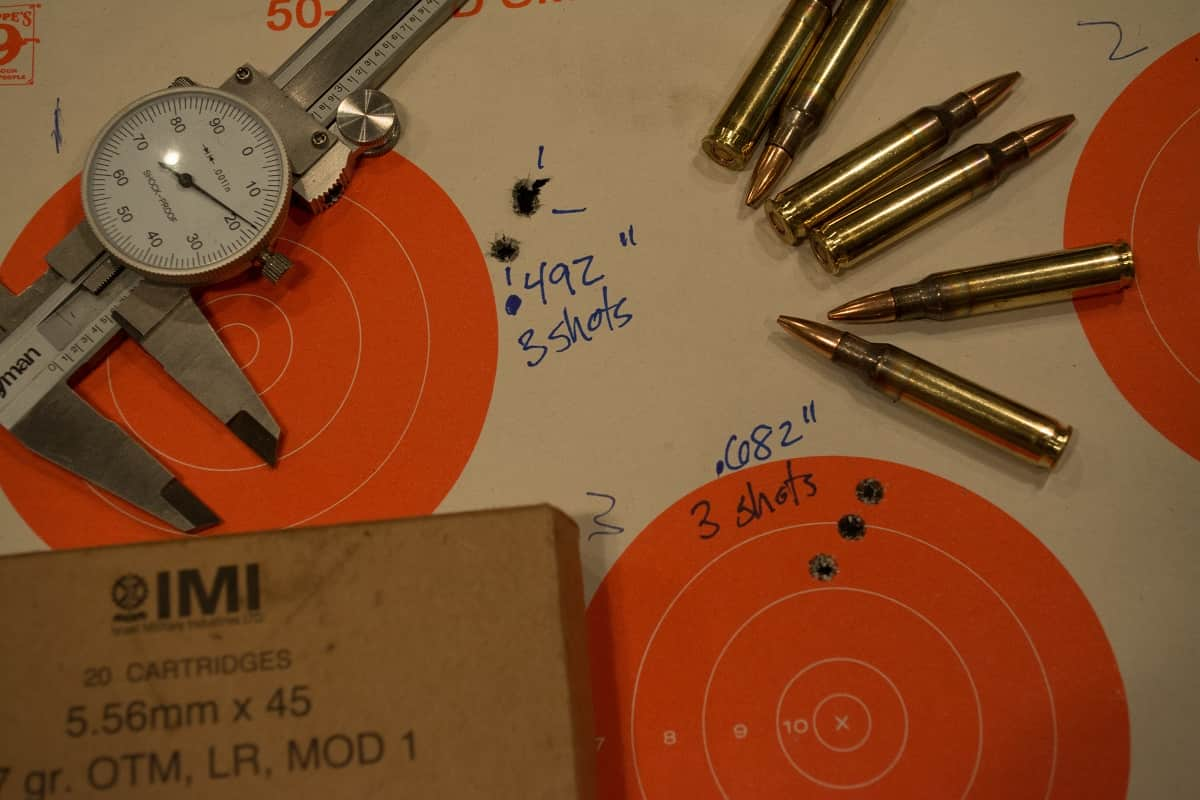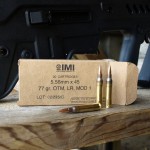IMI Razor Core 77-grain OTM 5.56x45mm Ammo
Matt Korovesis 06.19.14

I’m a relative newcomer to the 5.56x45mm round. The first gun I had chambered in 5.56 that was truly my own and not a “shared custody” piece between my father and I was my Tavor SAR. However, my inexperience with the round evaporated during extensive accuracy testing with the Israeli bullpup. I’ve now shot thousands of rounds of 55-grain XM193, 62-grain green tip, 77-grain Black Hills OTM (open tip match), and many others. I’ve also become intimately familiar with the high cost of quality 5.56. When word started getting around that Widener’s, a well-known firearms, ammo, and accessory retailer, was offering a new, affordable Israeli version of 77-grain OTM, I was very intrigued.

Seventy-seven-grain OTM 5.56 was first designed to be used in the US military’s designated marksman rifles in an effort to improve long-range performance and terminal ballistics. By all accounts, “mil-spec” 77-grain 5.56 variants have done just that. Accordingly, 77-grain 5.56 gained tremendous popularity in the “civilian” market. However, the availability of mil-spec 77-grain to the general gun market has been extremely limited, and often outrageously expensive (with prices hovering around $1/round at the lowest). Enter Widener’s affordable (as low as $0.75/round) and plentiful Israeli Military Industries (IMI) 77-grain OTM, which goes by the brand name “Razor Core.”
I had the pleasure to shoot some Black Hills 77-grain 5.56 through my Tavor roughly a year ago, and the ammo produced the best results of all the types of rounds I tested (1.5-inch five-shot groups at 100 yards). I desperately wanted more of the heavy stuff, but couldn’t justify breaking all 10 of my piggy banks just to scrape together enough funds for two 50-round boxes—bear in mind that this was at the height of the ammo-and-gun-buying panic. With Widener’s IMI 77s, I finally saw an opportunity to economically stock up on top-performing ammo.
But was it really top-performing? Widener’s advertises the IMI ammo as featuring Sierra MatchKing 77-grain HPBT (OTM) cannelured bullets (just like their Black Hills US counterparts) and a “military 41 type non-corrosive crimped-in primer that is waterproofed.” After ordering 200 rounds, I decided to put the ammo to the test with the help of star OutdoorHub contributor and premier paper-shooter Tom McHale. I sent him 40 rounds to test in his Smith & Wesson M&P15 VTAC I for accuracy and ballistic gel blowing-up capabilities, and selfishly hoarded the rest.

Tom quickly shot up most of the ammo I sent him and had some exciting results to report. For accuracy evaluation, Tom shot three-shot 100-yard groups with cooling and OTIS Ripcord bore-cleaning periods in between each. His two best groups were .492 and .682 inches—impressive numbers. His Shooting Master Beta Chrony set up 15 feet downrange recorded an average velocity of 2,703 feet per second after five shots, which is comparable to American 77-grain.
The ballistic gel results were also suitably encouraging. I won’t try to paraphrase here and will use Tom’s exact words in his email notes to me:
I shot the 77-grain load into clear ballistic gelatin blocks from a distance of 10 yards. I put two 16-inch-long blocks back-to-back and an old Kevlar vest behind in case the projectile passed through both cleanly.
These are open tip match bullets and not designed to expand so I had idea what to expect. Shooting into clear gel with no barrier caused the projectile to virtually explode about six inches into the gelatin block.
Each projectile broke into three different fragment tracks going deep into the gel. The jacket fragment stopped relatively quickly, between eight and 10 inches deep. The lead core went further to maybe 14 to 16 inches. With each shot there was a small fragment that went all the way through the first block and ended up somewhere into the second, usually four to five inches [in], and so that had a 20-inch total penetration.
After reading Tom’s emails, I was excited to try the ammo myself. I took my Tavor (newly outfitted with a Timney trigger) to the local DNR range and mounted a friend’s Trijicon AccuPoint 2.5-10x scope atop it. Keeping with Tom’s findings, the IMI 77-grain was very accurate in the Tavor. My five-shot groups at 100 yards averaged right at the 1.5-inch mark. I should also note here that I’m a crap marksman, and those results from my trigger finger wowed me even more than Tom’s. There were no malfunctions or weird cycling issues to speak of whatsoever.
The IMI 77-grain Razor Core OTM has impressed me in two significant ways: its low price point and exceptional performance. It’s a “budget” high-quality round that offers shooters sniper-grade groups at a more affordable price. Widener’s currently offers 500-round cases of the ammo for $375 each ($0.75/round) and 20-round boxes for $16 a piece ($0.80/round). I’d recommend that anyone looking for an excellent long-range, terminally-effective 5.56 round should give a few hundred rounds of IMI 77-grain Razor Core a try before dropping significant cabbage on its Black Hills brother.





